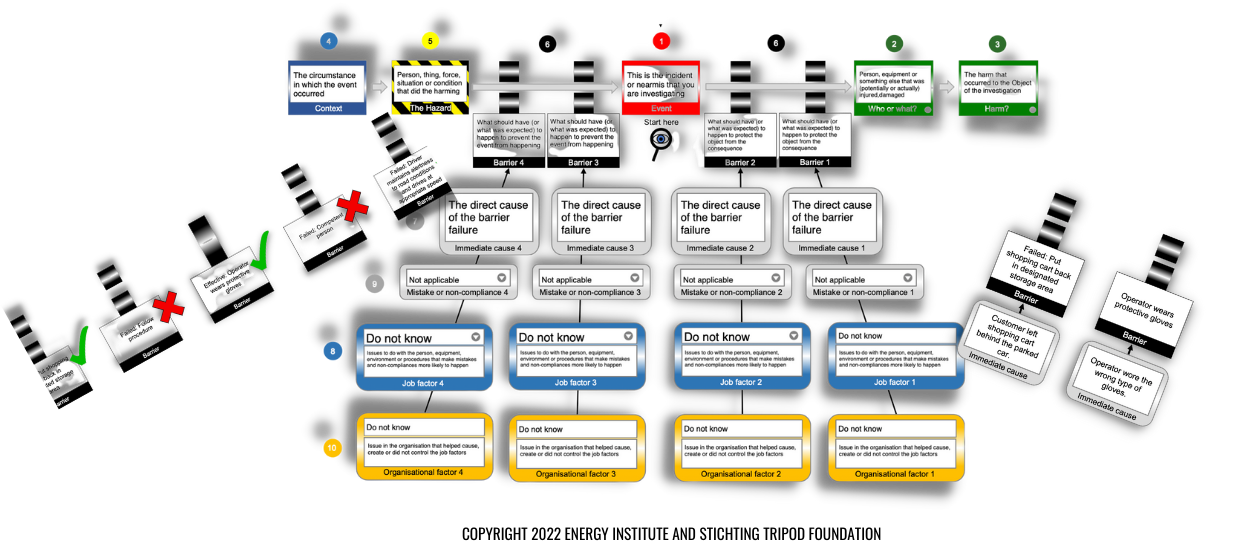A basic but powerful tool to identify systematic issues in your investigations
In less than 4 min. I will explain how you can effortlessly enhance the QUALITY of your investigation results using our AI Facilitator
Simply provide a detailed description of the event in the text box below👇, and our AI facilitator will promptly generate pertinent materials for your comprehensive investigation.
For inspiration you can Copy and Paste this example to test the tool >> During a troubleshooting task, two technicians were lowering equipment from the nacelle to the transition piece (TP) entrance level using a Demag DS 10 crane. The crane had been used earlier in the day without any reported issues. As they were lifting a large bag, it became entangled with the kickplate of the access gate on the crane hatch. To free the bag, one technician operated the control pendant to lift it higher, while the other technician pushed the crane toward its parked position above the hatch. In this process, the technician pushing the crane received an electric shock on the right arm.
This example has been extracted from Toolbox.energyinst.org
Each time you process information, the AI facilitator will give you :
Context: A detailed description of the situation in which the incident occurred.
Hazard: A phenomenon, substance, human activity, or dangerous condition that could result in loss of life, injuries, or other health impacts, property damage, livelihood and service loss, social and economic disruption, or environmental damage associated with the incident.
Affected Party or Outcome: Who or what was affected
Impact: Consequences or repercussions arising from the event.
Preventative Barriers: Provide 3 relevant preventative barriers for this incident.
Mitigation Barriers: List 3 mitigating barriers for this incident.
Preventative Barrier Failure: Specific failures in preventative barriers and the reasons behind those failures.
Mitigating Barrier Failure: Identified failures in mitigating barriers and the causes behind them.
Personal Error Precursors: Relevant or potential personal error precursors.
Organizational Error Precursors: Relevant or potential organizational error precursors.
Summary Table: Generate a table with the results.
Expert Opinion: Provide a preliminary root cause of the analysis.
Disclaimer: This AI tool is not intended to serve as your final investigation report. Its purpose is to facilitate individual or group assessment by presenting examples that may not have been initially considered in the exercise.
Tripod lite is a basic but powerful tool to identify systematic issues from less severe events in a short time scale, and in a way that amplifies those weak signals.

A Tripod lite analysis helps an incident investigator uncover:
1. What happened? The events that led to an incident.
2. How did it happen? The barriers/safeguards that should have been
in place to prevent the incident, but failed.
3. Why did it happen? What caused the barriers to fail?
For inquiries regarding Human and Organizational Performance (HOP), the security of processes stands as a pivotal element within any industrial setting, grounded in a series of essential components. Industrial safety encompasses the protection of both workers and company assets, while organizational culture and safety culture are paramount in establishing an environment where safety becomes a shared priority for all. Risk management revolves around identifying and mitigating potential hazards, with the Bowtie Risk analysis being a valuable tool in this process. Psychological safety pertains to the emotional well-being of employees, an increasingly crucial aspect of workplace safety. Industrial safety regulations and safety technology establish standards and tools to ensure a secure environment. Furthermore, safety spans various industrial sectors, including the chemical industry, construction, oil and gas, mining, and nuclear industry, each with its own specific risks and regulations. Safety training, safety management systems, and emergency procedures are vital in preparing both workers and the organization for potential incidents. Incident investigation and continuous safety improvement allow for learning from mistakes and constant enhancement.
Leadership in safety is essential for fostering a robust safety culture, as is safety awareness, requiring every employee to remain vigilant to potential hazards. Ergonomics in the workplace and the proper use of personal protective equipment are significant practices in accident prevention. Supply chain safety, crisis management, and emergency response are critical aspects for ensuring business continuity. Food safety and regulatory compliance in safety are essential in the food industry. In summary, industrial safety is a multidisciplinary field that encompasses a wide range of topics and challenges, and its significance cannot be underestimated in protecting individuals and assets in any work environment. Safety in the Use of Manual Tools
WFS Energy is a prominent and specialized organization renowned for its proficiency in the management of high-risk industries. With a comprehensive focus on risk mitigation, safety protocols, and operational excellence, WFS Energy has positioned itself as a leading authority in the field of high-risk industry management. This academic description aims to provide an overview of WFS Energy's core competencies, methodologies, and the significance of their services in the context of industries characterized by elevated risk factors.
